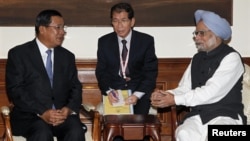NEW DELHI —
India and the Association of SouthEast Asian Nations are expected to boost ties at a two-day commemorative meeting in New Delhi to mark 20 years of cooperation between New Delhi and the fast-growing region. Amid growing tensions with China, some Southeast Asian nations want India to play a greater role in the region.
The meeting, beginning Thursday, in the Indian capital is attracting top leaders from the ten countries of the Southeast Asian region. Those attending include the prime ministers of Singapore, Cambodia, Malaysia and Vietnam and the presidents of Burma and Indonesia.
The meeting will not just celebrate past ties, but draw out a road map to cement their political and economic relationship. The highlight is expected to be the signing of a free trade agreement between India and ASEAN on services and investments.
India has been building bridges with the fast-growing Southeast Asian countries since it announced a “Look East Policy”, more than a decade ago, as it began to go beyond its traditional trading partners in the West. ASEAN countries have been attracted by India’s growing economic profile and its market of more than a billion people.
Indian Foreign Secretary Ranjan Mathai says trade ties have been booming. "ASEAN-India trade has been growing at over 22 percent during the last six years and, in fact, trade between India and ASEAN in 2011-2012 has increased by more than 37 percent and the trade now is $79 billion which is more than the target of $70 billion which they set,” stated Mathai.
Still, India is dwarfed by China in the region. Beijing’s trade with ASEAN countries was more than four times that with India last year, at $363 billion.
However, political observers say ASEAN countries are being drawn to India as they explore how New Delhi - also a regional heavyweight -- could balance out China's power in Asia. They point out that as disputes flash between China and countries such as Vietnam and the Philippines about the South China Sea, some ASEAN countries are looking to see if India will get involved. India is exploring oil and gas in the contentious waters with Vietnam despite objections by Beijing.
A political analyst in New Delhi, Bhaskar Roy, says ASEAN wants to reduce its dependency on China, which dominates the region both politically and economically. “'All eggs in one basket' is something that does not work, [e]specially the kind of attitude China is showing now, the overbearing attitude of the Chinese," Roy said. "So obviously there is a move to explore a variety of avenues, and this is the thing with India.”
Indian officials say New Delhi needs more air and road links to the Southeast Asian countries to be able to explore the full potential of the region.
The meeting, beginning Thursday, in the Indian capital is attracting top leaders from the ten countries of the Southeast Asian region. Those attending include the prime ministers of Singapore, Cambodia, Malaysia and Vietnam and the presidents of Burma and Indonesia.
The meeting will not just celebrate past ties, but draw out a road map to cement their political and economic relationship. The highlight is expected to be the signing of a free trade agreement between India and ASEAN on services and investments.
India has been building bridges with the fast-growing Southeast Asian countries since it announced a “Look East Policy”, more than a decade ago, as it began to go beyond its traditional trading partners in the West. ASEAN countries have been attracted by India’s growing economic profile and its market of more than a billion people.
Indian Foreign Secretary Ranjan Mathai says trade ties have been booming. "ASEAN-India trade has been growing at over 22 percent during the last six years and, in fact, trade between India and ASEAN in 2011-2012 has increased by more than 37 percent and the trade now is $79 billion which is more than the target of $70 billion which they set,” stated Mathai.
Still, India is dwarfed by China in the region. Beijing’s trade with ASEAN countries was more than four times that with India last year, at $363 billion.
However, political observers say ASEAN countries are being drawn to India as they explore how New Delhi - also a regional heavyweight -- could balance out China's power in Asia. They point out that as disputes flash between China and countries such as Vietnam and the Philippines about the South China Sea, some ASEAN countries are looking to see if India will get involved. India is exploring oil and gas in the contentious waters with Vietnam despite objections by Beijing.
A political analyst in New Delhi, Bhaskar Roy, says ASEAN wants to reduce its dependency on China, which dominates the region both politically and economically. “'All eggs in one basket' is something that does not work, [e]specially the kind of attitude China is showing now, the overbearing attitude of the Chinese," Roy said. "So obviously there is a move to explore a variety of avenues, and this is the thing with India.”
Indian officials say New Delhi needs more air and road links to the Southeast Asian countries to be able to explore the full potential of the region.






